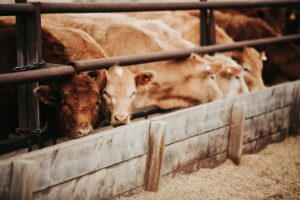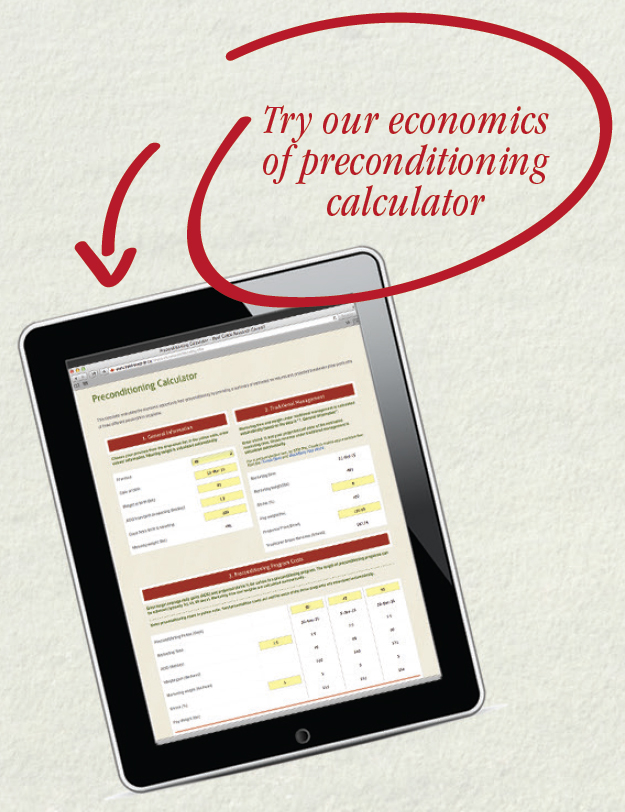Remarque : cette page web n’est actuellement disponible qu’en anglais.
Preconditioning Beef Calves

Calves shipped to the auction mart or feedlot immediately after weaning are stressed by separation from their mothers, transportation, co-mingling with unfamiliar calves, disease challenges, variable fall weather, and adjustment to unfamiliar feed, water and facilities. Each of these stresses can suppress the immune system and make freshly weaned calves more susceptible to bovine respiratory disease. Their impacts are worse when they all come at the same time.
Preconditioning aims to set calves up for success in the feedlot by spreading these stresses out, and reducing the large economic losses associated with high rates of acute respiratory disease morbidity and mortality in freshly weaned and transported feedlot calves1. Typically, preconditioned calves are:
- at least 4 months of age at weaning
- weaned for a minimum of 45 days prior to sale or shipment,
- accustomed to eating from a feedbunk, and
- vaccinated,
- castrated,
- dehorned, and
- treated for parasites at least 3 weeks prior to sale (Radostits, 2000).
Feedlots buying preconditioned calves can benefit from improved rates of gain and feed efficiency, lower treatment rates and death loss, and lower cost of gain. Studies from the Noble Foundation, Oklahoma State University and Kansas State University have demonstrated an increase in net value ranging from $13.71/head to $57.31/head for preconditioned calves, including the cost of the pre-conditioning program.
Cow-calf producers marketing preconditioned calves can benefit from heavier sale weights. Over time, preconditioned calves that consistently perform well in the feedlot may also attract price premiums, particularly with larger herds involved in direct marketing programs. These benefits must be weighed against the facilities, feed, management and health expertise needed to manage weaned calves at the same time as other farm operations (e.g. grain harvest), as well as the risk that calf prices often decline throughout the fall preconditioning period.
Calculator: Value of Preconditioning Calves
This calculator evaluates the economic opportunity from preconditioning by providing a summary of estimated net returns and projected breakeven price premiums of three different precondition programs.
To develop a preconditioning program that fits your budget and is tailored to your specific operation, consult with your local veterinarian.
The following webinar provides an overview of managing calves for improved productivity and reduced antimicrobial use, including a discussion on the economics of preconditioning.
Webinar recordings:
- References
-
Radostits, O.M. 2000. Control and Prevention of Diseases of Feedlot Cattle. Alberta Feedlot Management Guide.
- Learn More
-
What is the Value of Preconditioning Calves? (BCRC post)
Want More Money For Your Calves? Study Says Weaning & Preconditioning Pays (Beef Magazine)
Economic Considerations on Preconditioning Calves (Canfax Research Services)
The Lowdown on Preconditioning Calves (Canadian Cattlemen The Beef Magazine)
Visible and Invisible Benefits of Preconditioning Cattle (Grain News)
Feeder Calf Preconditioning and Backgrounding Guide (fédération des Producteurs de Bovins du Québec)
Feedback
Feedback and questions on the content of this page are welcome. Please e-mail us at info@beefresearch.ca
Acknowledgements
Thanks to Karin Schmid, Beef Production Specialist at Alberta Beef Producers for contributing her time and expertise during the development of this page.
Expert Review
This content was last reviewed September 2020.
Ce contenu a été révisé pour la dernière fois en Janvier 2024.

